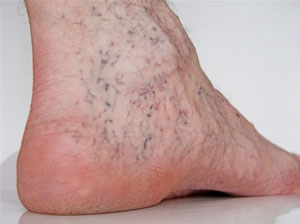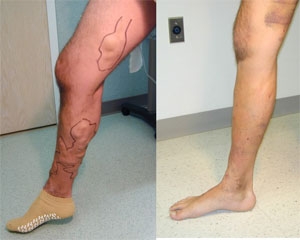Guide to Spider Veins
Vein problems that cause cosmetic concerns usually include spider veins or reticular veins. Small varicose veins with minimal symptoms may also be a cause of cosmetic concern for patients. Spider veins are small red, blue or purple veins within the layers of the skin that do not protrude above the skin surface. Spider veins are also called telangiectasias or telangiectatic veins.
Slightly larger blue veins that do not protrude above the skin are called reticular veins.
 Varicose veins are larger distended veins that are located below the skin level and somewhat deeper than spider veins.
Varicose veins are larger distended veins that are located below the skin level and somewhat deeper than spider veins.
There is no health risk regarding cosmetic veins, but they may be unsightly. Approximately 40% of people seek treatment to improve their veins for cosmetic reasons. Spider veins and reticular veins will never develop into varicose veins.
Treatments
Microwave Treatments: VeinWave™ and VeinGogh™ for Spider Veins
Cosmetically unappealing spider veins can be treated by a minimally invasive treatment that uses focused microwave energy. This method is appropriate for spider veins that are too small for sclerotherapy, including those on the face. Delivered through a very fine needle, the microwave energy is extremely precise in the way it targets these tiny vessels, so it is very effective without causing discomfort. The microwave energy causes the veins to seal and shrink. Most patients feel they see a 60 – 65% improvement in appearance, as many veins disappear and many lighten. Patients considering microwave treatments should expect significant improvement, but not perfection.
At this time, the center uses VeinGogh™, VeinWave™, and EVRF™ technologies. Dr. Elias, Director of the Vascular Surgery Vein Program, was one of the first physicians to use VeinGogh and was the first physician to use EVRF in the U.S..
Sclerotherapy for Spider Veins
 Sclerotherapy is the treatment of spider veins, reticular veins, and small varicose veins by injection of chemicals. This technique has been used for more than 50 years.
Sclerotherapy is the treatment of spider veins, reticular veins, and small varicose veins by injection of chemicals. This technique has been used for more than 50 years.
During sclerotherapy, a small needle (one of the smallest made) is inserted into the vein. A solution is injected that irritates the lining of the vein. In response, the vein collapses. The area of treated vein is then wrapped with a compression wrap for three to five days, depending on the vein size. This compression holds the vein together so it will seal shut. Over time the vein is reabsorbed and is no longer visible. There is minimal pain upon injection.
 Patients may need more than one sclerotherapy session for any vein region. Depending on the type and number of veins being treated, patients may need one or a number of injections per sessionNormalactivities can be immediately resumed after sclerotherapy. Medically prescribed support hose and/or bandages may need to be worn for several days to assist in resolution of the veins. The procedure usually causes only minimal discomfort. Bruising and pigmentation occur in less than 5% of patients after sclerotherapy: bruising typically disappears within one to two weeks, while pigmentation can last several months.
Patients may need more than one sclerotherapy session for any vein region. Depending on the type and number of veins being treated, patients may need one or a number of injections per sessionNormalactivities can be immediately resumed after sclerotherapy. Medically prescribed support hose and/or bandages may need to be worn for several days to assist in resolution of the veins. The procedure usually causes only minimal discomfort. Bruising and pigmentation occur in less than 5% of patients after sclerotherapy: bruising typically disappears within one to two weeks, while pigmentation can last several months.
With this procedure, veins can be treated at an early stage, helping to prevent further complications.
Next Steps
If you are in need of help for a vascular condition, we’re here for you. Call us now at (646) 317-8282 or fill out our online form to get started today.
Related Topics
- Aortic Aneurysm
- Carotid Artery Disease
- Chronic Venous Insufficiency (CVI)
- Deep Vein Thrombosis (DVT)
- Minimally Invasive Vein Surgery
- Pelvic Vein Disease
- Peripheral Arterial Disease
- Renal & Mesenteric Arterial Occlusive Disease
- Sclerotherapy for Vein Disease
- Thoracic Outlet Syndrome (Vascular)
- Thrombophlebitis
- Varicose Veins
- Vein Disease Overview
- Venous Leg Ulcers
This content has been created by Columbia’s Health Guide Team. Learn more about our efforts to bring you the clearest, most accurate, and most human health resources available.
